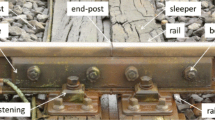Abstract
This article presents a methodology for the experimental testing of impact of the wagons with a special attention on the identification of wave phenomena and influence of sampling frequency on accuracy of the measured data. The impact force, affecting the buffers of Hccrrss wagon, has been captured at different sampling frequencies. The experimental results were compared to the theoretical ones obtained by the numerical simulation of two impact wagons. The wagons are modeled as two homogeneous elastic rods. The output results of such simple model were speed and time of wave propagation through the supporting structure of the tested wagon. They allow identifying and explaining the wave phenomena in results obtained by the experimental testing that must be carried out in process of certifying the wagons in accordance to the international regulations. In order to maximize the accuracy of the measured data, it is recommended to perform the experimental measurement at as high as possible sampling frequency. This methodology ensured a reliable measurement of the impact force on the buffers and identifying the wave phenomena generated through the subjected wagon.
Similar content being viewed by others
References
Iwnicki, S.D., Handbook of Railway Vehicle Dynamics, Taylor & Francis, Boca Raton, USA (2006).
Andersson, E., Berg, M., and Stichel, S., Rail Vehicle Dynamics, Railway Group KTH, Stockholm (2007).
Wickens, A.H., Fundamentals of Rail Vehicle Dynamics, Swets & Zeitlinger, Lisse, Netherlands (2003).
Garg, V.K., and Dukkipati, R.V., Dynamics of Railway Vehicle Systems, Academic Press, New York, USA (1984).
Popp, K., Kaiser, I., and Kruse, H., “System Dynamics of Railway Vehicles and Track,” Archive of Applied Mechanics 72(11–12):949–961 (2003). doi:10.1007/s00419-002-0261-6
Recommendations ERRI B 12/RP 17, B 10/RP 12, B 55/RP 8.
UIC CODE 518 OR, Testing and approval of Railway vehicles from the point of view of their dynamic behavior—Safety—Track fatigue—Running behavior. 4th edition (2009).
Goldsmith, W., Impact, the Theory and Physical Behaviour of Colliding Solids, E. Arnold, London (1965).
Puja, I.W., Khairullah, A., Kariem, M.A., and Saputro, A.H., “Numerical and Experimental Study on Railway Impact Energy Absorption Using Tube External Inversion Mechanism at Real Scale,” Key Engineering Materials 306–308:315–320 (2006). doi:10.4028/http://www.scientific.net/KEM.306-308. 315
Timoshenko, S., and Gudier, J.N., Theory of Elasticity, McGraw-Hill Book Company, New York (1951).
Versinskiy, S., Danilov, V., and Celnokov, I. Dinamika vagona. Izdateljstvo Transport, Moskva (1978).
Petrovic, D., Bizic, M., and Djelosevic, M., “Determination of Dynamic Sizes During the Process of Impact of Railway Wagons,” Archive of Applied Mechanics 82:205–213 (2012). doi:10.1007/s00419-011-0549-5
Rakanovic, R., Petrovic, D., Soskic, Z., and Simovic, T., Examination of Mechanical Structures, University of Kragujevac, Faculty of Mechanical Engineering Kraljevo, Kraljevo, Serbia (2006).
Author information
Authors and Affiliations
Corresponding author
Rights and permissions
About this article
Cite this article
Bizic, M., Petrovic, D., Djinovic, Z. et al. Experimental testing of impact of railway wagons. Exp Tech 39, 69–78 (2015). https://doi.org/10.1111/j.1747-1567.2012.00850.x
Received:
Accepted:
Published:
Issue Date:
DOI: https://doi.org/10.1111/j.1747-1567.2012.00850.x




